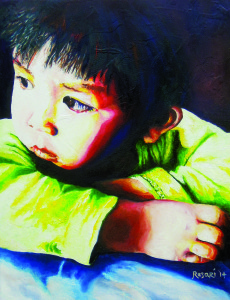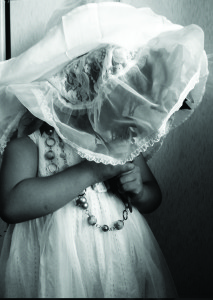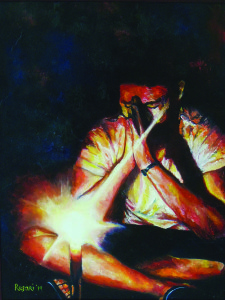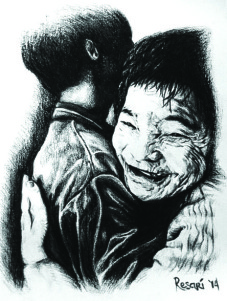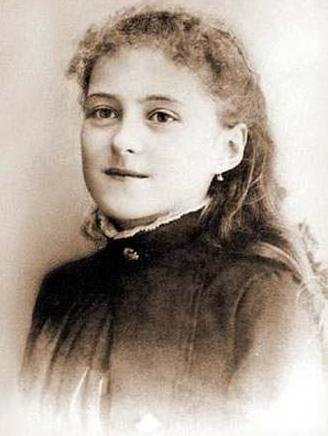Misyon Online - March-April 2016
Pulong ng Editor
‘He is risen, as he said, Alleluia’
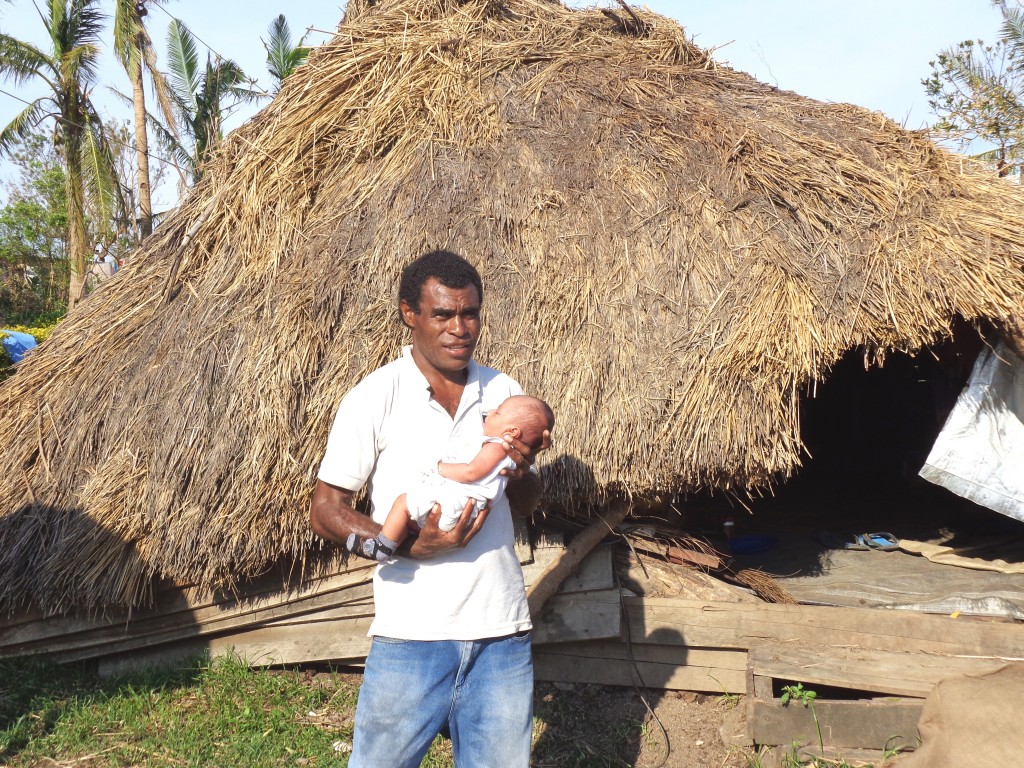
Natanuku catechist with grandchild in front of collapsed bure
‘We have to care in a special way for children and for grandparents. Children and young people are the future; they are our strength; they are what keep us moving forward. They are the ones in whom we put our hope. Grandparents are a family’s memory. They are the ones who gave us the faith, they passed the faith on to us.’
Pope Francis spoke these words at the Prayer Vigil for the Festival of Families in Philadelphia, USA, on 26 September 2015.
Just a year before that the Pope addressed a gathering of elderly people and grandparents in St Peter’s Square. He welcomed two brothers from Qaraqosh in northern Iraq which ISIS had taken over on 6 August 2014 and all the city’s people had fled to Iraqi Kurdistan. The Pope said , ‘These brothers testify to us that even in the most difficult of trials, the elderly who have the faith are like trees that continue to bear fruit.’
Speaking in a more general sense Pope Francis said, ‘Grandparents, who have received the blessing to see their children’s children (cf. Ps 128: 6), are entrusted with a great responsibility: to transmit their life experience, their family history, the history of a community, of a people; to share wisdom with simplicity, and the faith itself — the most precious heritage!’
The Bishop of Rome finished his talk with a very tender but powerful image: ‘One of the most beautiful aspects of family life, of our human life as a family, is caressing a baby and being caressed by a grandfather and a grandmother.’ The catechist in Natanuku, Fiji, in the photo above exemplifies those words.
He is not an old man but he is a grandfather. He is standing outside the family home destroyed by Cyclone Winston on 20 February, the strongest storm ever recorded in the Southern Hemisphere, with the same strength as Typhoon Haiyan/Yolanda that hit the Philippines on 8 November 2014 and described by Columban Fr Frank Hoare in A Killer Cyclone in this issue. The calm hope in his face along with his strength and tenderness – two qualities that go together – as he holds his grandchild protectively are symbols of the Resurrection, which we celebrate this year on 27 March.
Each year at the Easter Vigil we listen to the story of the Exodus, how God led the Hebrew people under the leadership of Moses from slavery in Egypt to freedom in the Promised Land of Israel. In Jewish families this same passage is read during the Passover Seder, the special family meal, and the youngest child present asks, ‘Why is this night different from all other nights?’ This is one of the ways in which Jewish families pass on their faith to their children.
We too pass on our Christian faith and our own personal, family and community history that is entwined with it. The catechist in Natanuku will continue to teach our Catholic Christian faith to the people in his community and will tell his grandchild about Cyclone Winston, of which the infant will have no personal memory. In conveying that story, which the child will hear from many others also, he will share how the deep faith of the Fijian people enabled them to experience the presence of the Risen Lord in the aftermath of Winston, just as the deep faith of the Filipino people enabled them to experience his presence in the aftermath of Haiyan/Yolanda.
Truly, He is risen, as he said. A Happy Easter!
A joyful proclamation of the Resurrection from Lebanon, a small country that suffered from a catastrophic war between 1975 and 1990 and that is home today to around 4.5 million people in addition to approximately 1.5 million refugees from conflicts in Syria and Palestine.
A Glimpse of Love for the Unseen
By Jao Resari
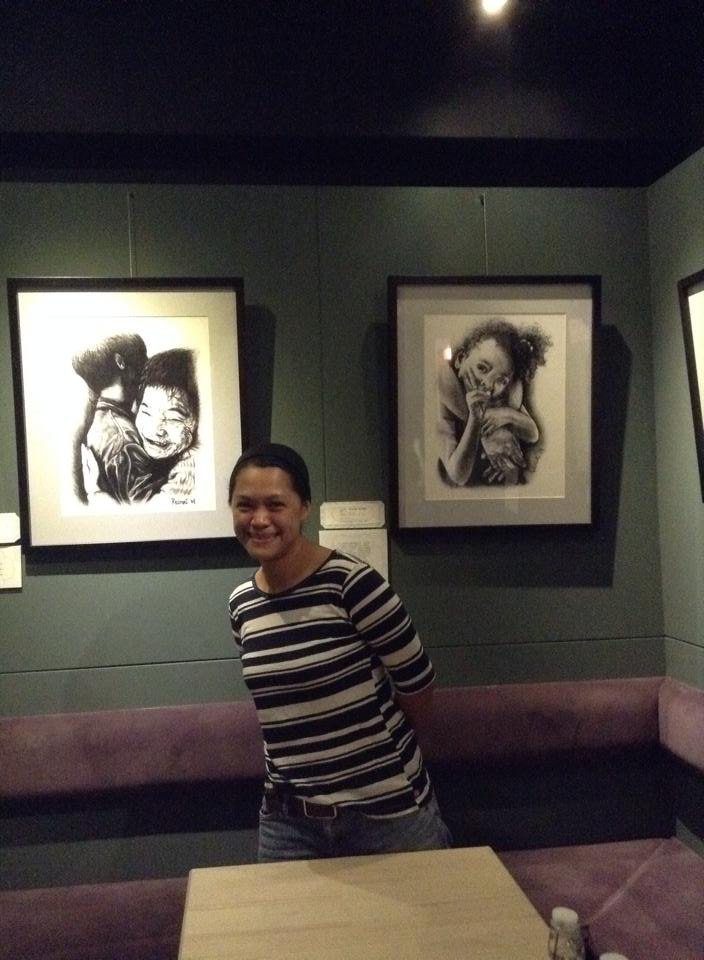
Jhoanna Resari at an exhibition of her art work
Jhoanna ‘Jao’ Resari is a Columban Lay Missionary from Rizal who is now based in Hong Kong as a member of the Lay Missionary Central Leaderships Team. She worked in Taiwan from 2005 until 2014 and has featured on MISYONonline.com a number of times. You may read more about her in our January-February 2016 issue here.
From 29 September to 19 October 2014 the Agape Center for HIV and AIDS Education and Outreach Ministry of the Hsinchu Diocese and Harmony Home Foundation Taiwan, a non-profit organization sheltering people living with HIV and AIDS in Taiwan and China, collaborated in holding a charity art exhibition entitled: ‘A Glimpse of Love for the Unseen’, showing 22 artworks which included oils, charcoals and photographs, to raise awareness on HIV and AIDS. The exhibition was held in two venues, the first in Hsinchu City and the second in Taipei City. These events were good opportunities for people from different communities to understand the realities of HIV and AIDS and to be in solidarity with people living with HIV and AIDS.
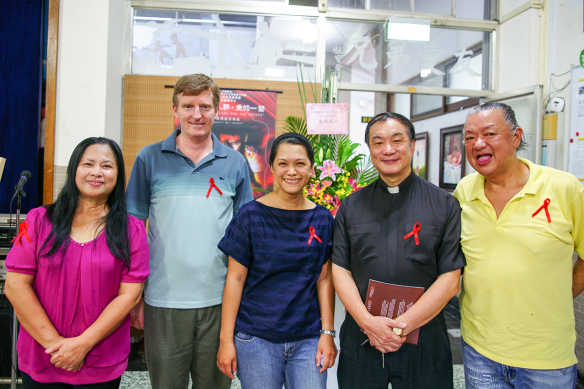
Hsinchu exhibition 1st opening, L-R: Nicole Yang, founder of Harmony Home Foundation Taiwan; Fr Peter O'Neill, director of Hsinchu Migrants and Immigrants Service Center and Migrants' chaplain of Diocese of Hsinchu; Jao Resari, Agape Center; Bishop James Li Tan-kuei, Bishop-Emeritus of Hsinchu; Teacher Hank, volunteer of Harmony Home Foundation Taiwan
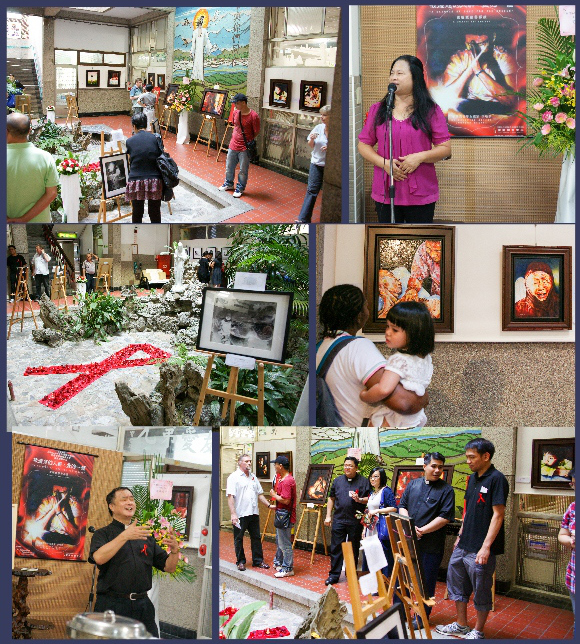
It is with a grateful heart that I share with you the reflection I wrote for the exhibit introducing my collection:
Since coming to Taiwan as a Columban lay missionary, I’ve had the opportunity to journey with people who live on the margins of our society, people from different walks of life having one thing in common – they are living with and affected by HIV and AIDS.
It was in Harmony Home, where I worked for five years as a full-time volunteer, that my eyes and my heart were opened to how the realities of HIV and AIDS have deeply affected thousands of lives in Taiwan, in China and in other parts of the world.
Most of the artworks I’ve created are captured moments in the everyday lives of people living with and affected by HIV and AIDS. The portraits are of faces unseen by our society. Most often, we see them under statistics or demographics. But they are more than just numbers – they are somebody’s family, relative, neighbor or friend, from newborn babies to teenagers, single mothers to old people. Each person has a sacred story to tell, be it their struggles or fears, joys and dreams.
‘What’s on Your Mind, Child?’ | Oil PaintingFacing the Truth
The stigma attached to and the discrimination against people living with HIV and AIDS are what fan the fire of this epidemic. For many people, it is easier to ignore what is happening right before their eyes than to face the reality; for others, it is more bearable to push people who are different from them outside their circle, hiding behind their walls of indifference. Sadly, many still believe that HIV and AIDS have nothing to do with them or their loved ones.
'I Want to be a Happy Bride Someday' | PhotographThe truth is that we are all vulnerable to HIV. All of us are affected by the epidemic. Each person’s attitude, behavior, actions, and choices affect others and also affect our community. So if one of us has HIV, then all of us have HIV.
Finding Hope
In deepening our awareness of how HIV and AIDS affect lives, we can begin to understand our own important role in fighting this epidemic.
'Finding Light in the Dark' | Oil PaintingHaving witnessed how HIV has drastically affected thousands of people, young and old, I hope that this exhibition can open more eyes, more hearts into seeing that there is hope after HIV and AIDS; hope in stopping the spread of this illness – and that hope lies in each of us taking action now.
Witnessing Love
This exhibition was also a tribute to the good works done by many people who have been working in solidarity with people living with HIV and AIDS. Their acts of kindness and compassion, untold in news or in the media, but nevertheless, they are the ones who continue to give hope to the hopeless, healing deep wounds caused by fear and ignorance.
It is humbling to witness the power of love overcoming the challenges of HIV and AIDS in the lives of people living on the margins of our society.
'More Than a Hug' | CharcoalTrue Love compels us to action. I hope that more people may find the courage to face the challenges brought about by HIV and AIDS, as well as value the life, love and dignity of each person, including people living with and affected by HIV and AIDS.
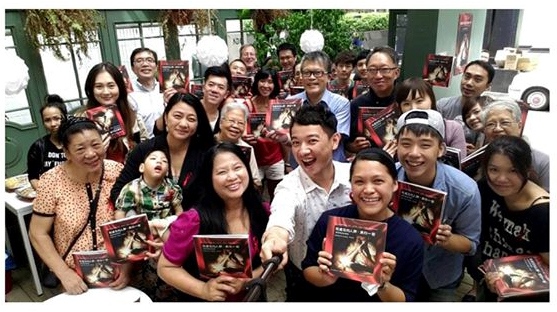
Taipei exhibition 2nd opening, Press conference, Jao Resari with Nicole Yang, staff,
volunteers and residents of Harmony Home, local media and guests
A Killer Cyclone
by Fr Frank Hoare

A wrecked house in Natanuku
Columban Fr Frank Hoare, based in Fiji, first went there in 1973. He is from Ireland.
Severe Tropical Cyclone Winston
In mid-February this year Tropical Cyclone Winston passed fairly close to Fiji on an eastward path towards Tonga. It missed the large islands but did damage to some of the smaller Lau islands. It damaged one of the big islands in the Tonga group and then made a sharp U turn picking up force from the heat of the ocean below as it reversed its path towards Fiji. The government issued warnings to everyone to prepare for the cyclone by nailing wooden shields over windows, by tying down roofs with wire, by storing up food and water and candles and by buying batteries for radios and flashlights. Evacuation centers in schools and halls were prepared.
The cyclone passed over the Lau islands again on Saturday, 20 February. It went over the Lomaviti islands in the middle of the Fiji group before steering a path between the two main islands, Viti Levu and Vanua Lev. It finally passed over the Yasawa group and moved south-east between New Zealand and Vanuatu. It was a force 5 cyclone, the strongest every to pass through the South Pacific, with average winds of 250 kph and gusts of up to 320 kph Its slow pace – about four hours to fully pass any point – exacerbated its effects. The winds were accompanied by torrential rain, and some of the coastal villages were also swamped by massive waves washing over them sweeping up everything in their paths. The smaller islands were struck during daylight, otherwise the 43 deaths recorded would have been far exceeded. 50,000 families are now reported homeless.
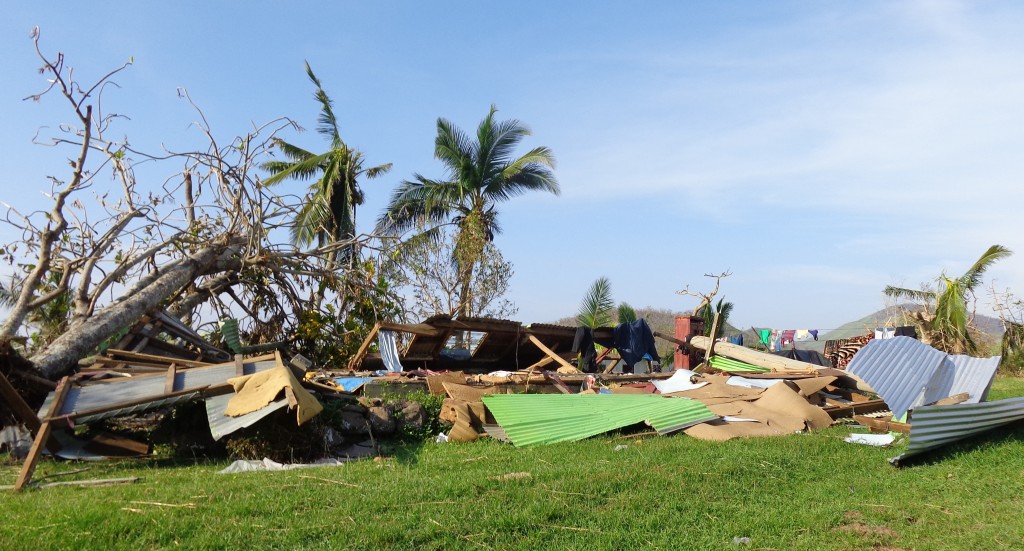
Devastation in Natanuku
Ba Parish
The Columban parish of Ba felt the force of the cyclone from about 6:30 p.m. until 10:30 p.m. Fr Nilton Iman (from Peru) and Fr John Lee (from Korea) are both young Columban Associate priests who had taken over Ba parish two months previously. They had never experienced anything like this. Fr Nilton was white and speechless with fright. Fr John thought he would not survive the night. Some louvers in the presbytery (convento) were smashed, and the ferocious wind and heavy rain poured in knocking pictures from the walls, scattering glass, books and clothes over the floor and flooding the rooms. Downstairs parish workers Mosese and Peni with a visitor, Mosese Junior, saw the louvers in the side wall of the garage bulging inwards from the force of the wind. They feared that if the windows gave way then the new parish van would be thrown against the pillars and damaged.
Mosese Jr and Peni tried to hold the louvers despite slipping on the wet floor while Mosese Sr searched in vain ffor a hammer. Mosese Jr was scared that the wind would shatter the louver glass and that the shards would slam into his face. As Mosese Sr returned with a half concrete block the other two gave up on the louvers and retreated to the garage. Mosese shouted to them, ‘Hold those windows – they are our life-saver.’ The two returned and piled one table on top of another, and Mosese Sr nailed them against the windows with the make shift hammer.

Natanuku catechist with grandchild in front of collapsed bure
The experience in the villages
Meanwhile in Natanuku village about 15 kilometers away Catholic villagers welcomed Methodists and members of the Assemblies of God into their newly build church. The Catholic catechist opted to remain with his family and two other families in his Fijian style thatched house. Sometime during the ordeal the main posts of his house gave way and the thatched roof sagged to the ground. The three families survived the terrifying storm squashed together in a small cave like space under the roof. Back in the church as the storm abated one of the Catholic leaders, also named Mosese, remarked to the people, ‘I notice a few new faces here tonight. The bell rings every Sunday and some of you seem a bit deaf to it. Tonight there was no bell but you are here!’
Votua is a big village on the Ba river with houses close together. Their veteran catechist, Ramoce, said that they were surprised that the cyclone came, not from the east as they had expected from past experience, but from the south. The noise of the galvanized iron being folded back, being torn off roofs and smashing into other roofs was deafening and terrifying. The children screamed and the mothers cried inside the houses. People emerged from damaged houses and risked injuries from flying timber and roofing iron to rush into stronger houses nearby. Ramoce pushed tables and heavy wet mattresses against the windows of their house. They were grateful that, because the Ba river had been dredged after the last flood, the river didn’t overflow its banks and flood the village as well. After the cyclone some people complained that the terrible noise of that night was still echoing in their ears. Traumatic memories continue to haunt many.
Iowane, the catechist from the nearby Nawaqarua village, left his family in their solid concrete house to keep watch alone in the village timber church. He was worried about the safety of the Eucharist there. After some time the howling wind burst open the front door of the church. Iowane opened a side door to allow the wind an escape passage rather than risk the roof being blown off. The mats and linoleum were soaked, but the church and Eucharist were saved.
The Aftermath
Back in the parish center when the cyclone had passed on about 10:30 p.m. Peni mixed some yaqona, the traditional Fiji drink, for Frs. Nilton and John Lee who had joined them during the cyclone and were now unable to sleep. There was a call for a hymn, and Fr. John started a hymn to Mary. Fr. Nilton followed up with a hymn to Christ. Mosese shared his amazement that small, light Fr. Nilton had pulled a very heavy tool box, without any help, against the garage door that was smashed open by the wind. Mosese had previously been unable to move that tool box.
When I visited the villages of Natanuku, Votua and Nawaqarua a few days after the cyclone with some food rations I found the villagers nailing down roofs, clearing up fallen debris and drying out clothes and mattresses. Old friends greeted me. The catechists Ramoce and Iowane invited me to share a bowl of yaqona. I was glad to see that the government rations had begun to reach the most affected. As I drove away, the sky was red with the setting sun behind me and the smoky flames of the fires burning rubbish were dotted throughout the village. I was struck with admiration for the courage, faith and good humor of the people of Fiji who refused to be crushed by this very traumatic experience.
A Present-day Good Samaritan
by Fr Barry Cairns
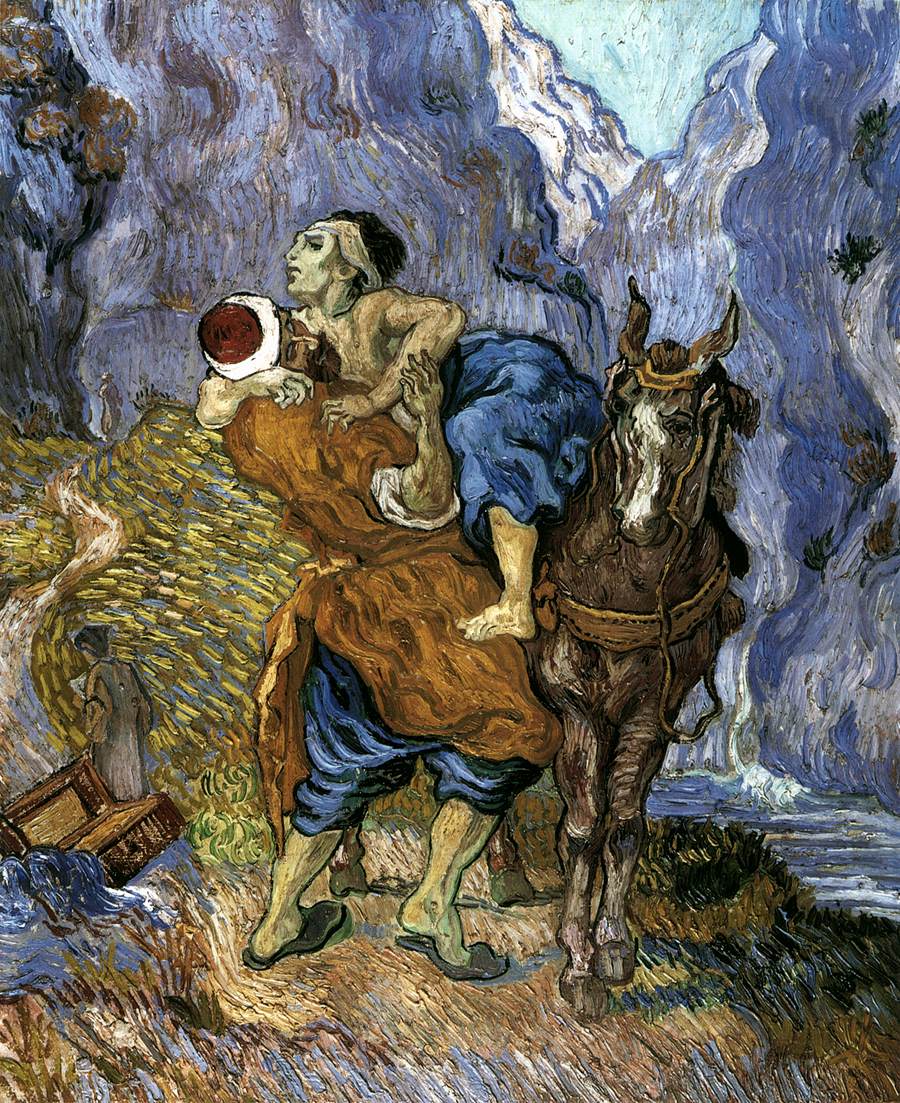
The Good Samaritan (after Delacroix), Van Gogh
May 1890, Saint-Rémy.
Rijksmuseum Kröller-Müller, Otterlo, Netherlands [Web Gallery of Art]
One of my recent side jobs was to teach for a term as a substitute lecturer at a junior college in Yokohama. There were 30 students in the class. Many were destined to be social workers in Christian-run homes for children with disabilities, retirement homes and hospices. Not one of the students was a Christian. For this reason, the dean of the College asked me to give a ten-week course entitled simply, ‘Christianity.’ At my request each student was to have a copy of the New Testament and a copy of Shūsaku Endō‘s Life of Jesus. (Both in Japanese as were the lectures.)
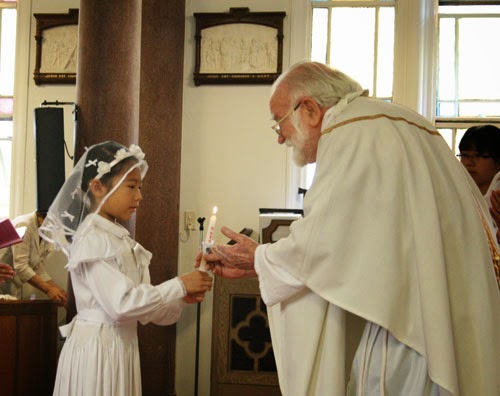
Fr Barry Cairns with First Communicant, Japan
At the end of the term there was an exam. I gave the students four essay-type questions. One was, ‘Open your New Testament at the Gospel of Luke, chapter ten, verses 25 – 37 and give a modern day version of the parable of the Good Samaritan.’
One student’s answer left me with a deep, lasting impression. I remember this student well. He sat in the front seat on my left. In the first class after the long summer vacation, he still seemed to have a holiday air. His hair stood in spikes that were dyed green. He wore long earrings. This is my translation of what he wrote ten weeks later.

When I was in my first year of high school I was the smallest in my class. My eyesight was poor and I wore thick glasses. I stuttered with nervousness when a teacher would ask me a question. I was not athletic and was bullied by my classmates. Even my homeroom teacher would sometimes imitate my stutter.
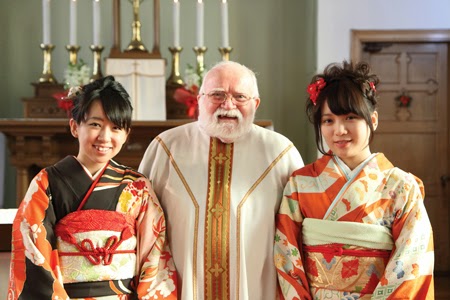
Fr Barry Cairns with Izumi and Mina, two 20-year-old parishioners celebrating Coming of Age Day.
I was lonely and my heart felt wounded. I used to take my lunch box to the far side of the sports oval and eat alone. One day a classmate came over and sat beside me. At first he just sat on the bench and was quiet. Somehow I felt his compassion. Then he said to me, 'I am of Korean ancestry. In Japan we bear discrimination as you know. I know what it is like to be bullied and lonely. Take heart and let’s face school life together. You are not alone.'
From that time a great healing began within me. I felt the beginning of a new self-confidence. Over the years this new life has matured. And here I am training to be a social worker to help the disadvantaged. I am here because of that Korean Good Samaritan who was so gentle with me. Now I am going to do likewise.

I took his paper to the dean to explain why I had given him an A+.

Columban Fr Barry Cairns, a New Zealander, was ordained in 1955 and has been a missionary in Japan since 1956.
In the footsteps of Columban Missionaries in China
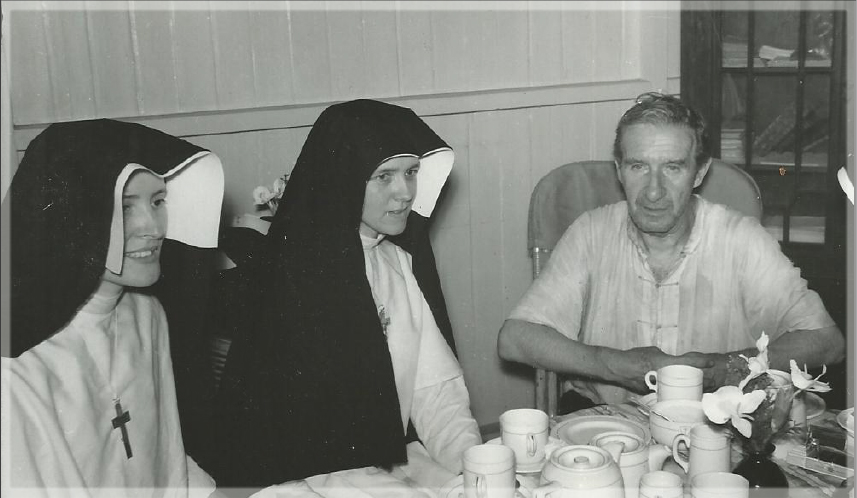
Bishop Edward J. Galvin
19 September 1952 at convent of the Columban Sisters, Hong Kong
Bishop Galvin, Co-founder of the Columbans and first Bishop of Hanyang had just been expelled from the People’s Republic of China
This article first appeared in Sunday Examiner, the English-language weekly of the Diocese of Hong Kong edited by Australian Columban Fr James Mulroney.
HONG KONG (SE): In the manner in which St Columban proclaimed himself an exile for Christ when he left his native Ireland for Europe over 1,400 years ago, a group of Chinese priests, sisters and lay people from Wuhan carried a banner reading ‘Exiles for Christ’ as they traveled in pilgrimage along the Han River from Hanyang between 11 and 14 November 2015 in the footsteps of the Columban missionaries of the 1920s.
The organizer of the pilgrimage, Father Joseph Li, said that the three-day journey served to awaken something in the hearts of all who took part. ‘We felt a communion and a togetherness with the missionaries who did so much to nourish the faith among our communities,’ Father Li reflected.
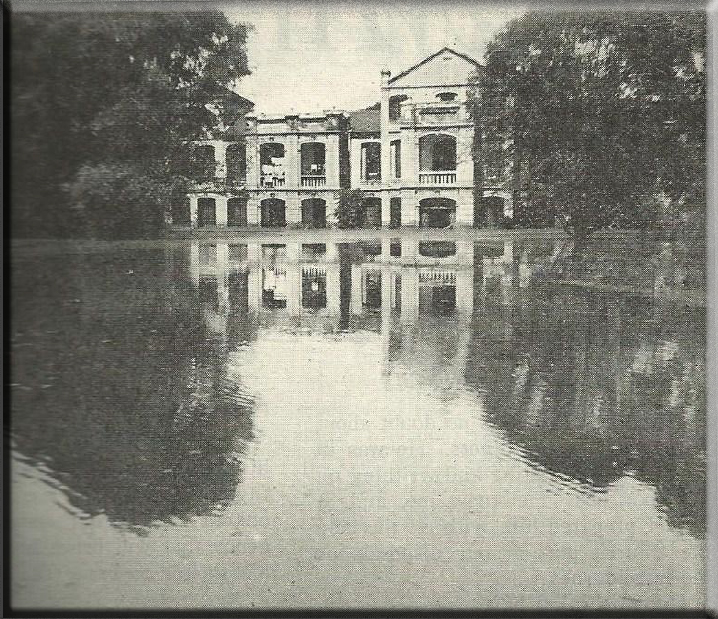
Floods in Hanyang, August 1931
Sister Li, from Xianto, said that she was conscious of a deepening gratitude forming inside her heart, as her appreciation of the growth of the faith in Hanyang deepened. She said that when the group stopped at the hilltop where hundreds of thousands of refugees huddled during the great floods of 1931, she was filled with awe listening to the story of the work that the Bishop Edward Galvin and the Columban Sisters and priests did in sustaining them over the six to eight months their homes remained under water.
‘Now I feel I am more ready to be an exile for Christ myself,’ Sister Li said.
Traveling in four minibuses, the 28 pilgrims covered a distance of some 300 kilometers, as they wound their way along the twisted path of the Han River. At each stop they raised the red banner bearing the words of St Columban, ‘Peregrinari pro Christo’ (‘To be pilgrims/exiles for Christ’) to capture something of the spirit that drove him to leave his homeland, renounce his position and social status, to preach Christ in a hostile environment.
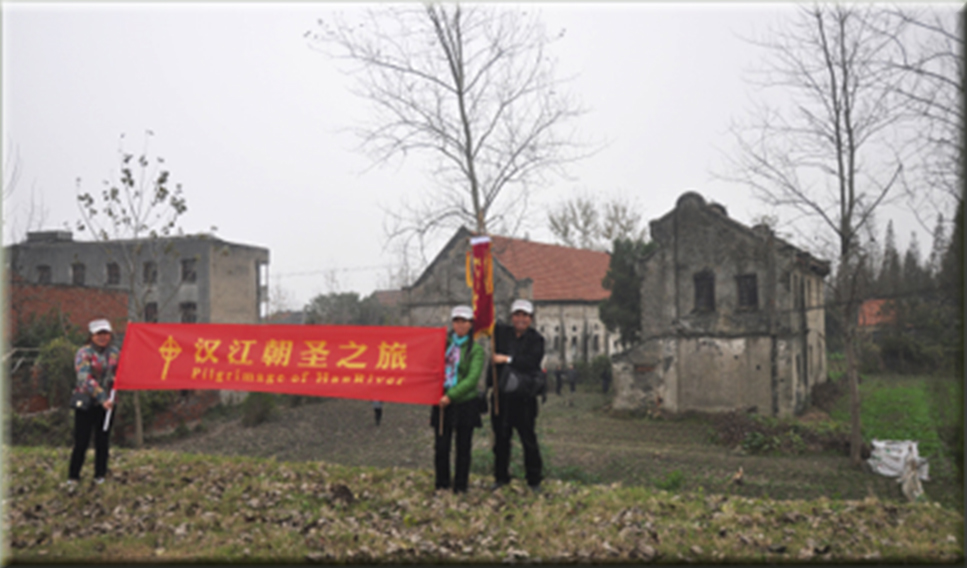
Pilgrims with banner in Shau Town Village
The group visited Shau Town Village, where local people told them that there are no longer any Catholics, but the ruins of what was once a sizeable stone church and a two-story convent and rectory now stand only as a monument to what was once a thriving faith community.
At another stop, a former seminary, displaying fine architecture and still in good repair, as it is now used as a dormitory for government workers, reflects a past hope that although dented, refreshed the determination of the pilgrim group to cherish their faith and work to build strong local Church communities in the future.
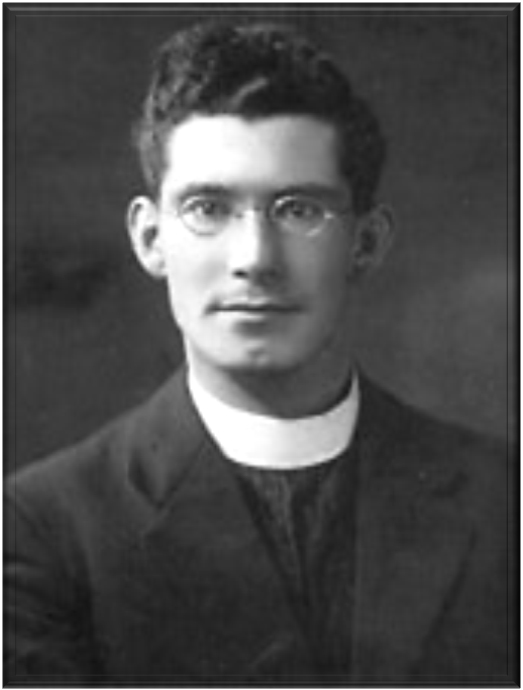
Fr Charles Cullen
(1897 – 13 July 1923)
But most moving of all were the tombs of the Columbans who died in China. Father Charles Cullen came from Ireland in the 1920s, but died two years later at the age of 27. Bishop Galvin wrote of his death, ‘When night came . . . there was no coffin to be had. In this appalling difficulty, a friend turned up where you least expected to find one. A pagan gave the coffin he had prepared for himself, and a very fine one it was!’
At this point, a priest suggested that the exact place of his burial be located and a replica of the coffin be made and reburied at the parish church. But as the group reflected on this, one asked why, as Father Cullen is already in the place where he belongs. Another said, ‘Most people look for a place to settle down, but Father Cullen was a missionary and his life was lived on the road.’
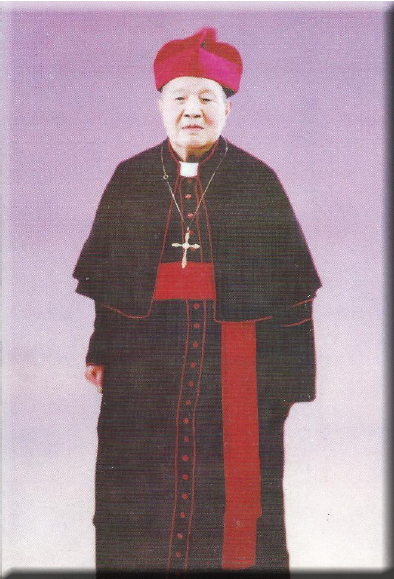
Bishop Peter Zhang Bairen
Second Bishop of Hanyang
The group was further inspired at the tomb of Bishop Peter Zhang Boren (or ‘Bairen’), the first Chinese bishop of Hanyang, who died in semi-isolation in a small village in 2005, where he had been an English teacher to small children since his release from prison.
Bishop Zhang was a subject of intense interest to the Communist Party in the early 1950s, as he was seen as a prize candidate for the newly-formed Chinese Catholic Patriotic Association. He subsequently spent 24 years in prison, before being released and sent to teach English in a village, which he found difficult after not using the language for so long. However, he was able to carry on a clandestine ministry among the people and was buried with honor by the local Catholic community.
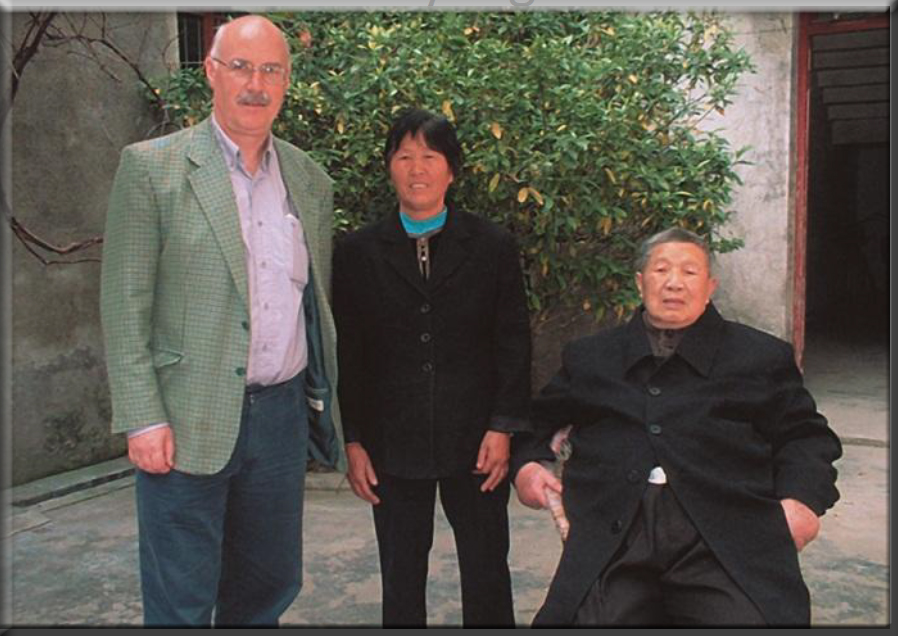
Bishop Zhang with Columban Fr Tommy Murphy and friend
One night in a darkened hotel room near an old labor camp where priests had been interned in the past, the pilgrims fasted as they gathered to share their reflections, just as they shared the light of the candles placed on the table where the Eucharist was to be celebrated.
Father Li told stories of the exiles for Christ who brought the good news of Jesus to the far reaches of the world, likening it to the beginning of the sojourn of Abraham, our father in faith, and then the spread of Christianity from Europe into Asia through people like St Columban and, finally, the missionaries like him who proclaimed the faith in Hanyang.
At the final destination of Bai Hu Village, Tianmen, the Chinese priests donned red stoles for a Mass in remembrance of the sacrifices, sweat and tears of all those who had donated their lives to the passing on of the faith and are now buried in their land like seeds of belief.
Father Li concluded, ‘In their lives, and even in death, they are an inspiration.’

Remembering Fr Charles Cullen
Fr Charles Cullen was the first member of the fledgling Missionary Society of St Columban to die, on 13 July 1923 in China. The Chinese pilgrims following in the footsteps of Columban missionaries in China visited his grave. Ninety years later his relatives honored his memory.
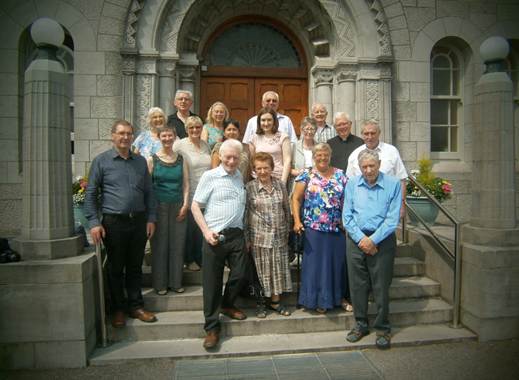
Fr Charles Cullen’s relatives at Dalgan Park
The Cullen family gathered at St Columban’s, Dalgan Park, Navan, Ireland on Saturday 13 July 2013 to take part in a special Mass to commemorate the 90th anniversary of the death in China of Father Charles Cullen, and to remember and pay tribute to their uncle.
Fr Neil Collins, a historian who worked in Mindanao for many years and who has written a history of the Columbans, The Splendid Cause, was the principal celebrant of the Mass, assisted by Fathers Gerry Neylon and John McGrath of the China Mission Unit.
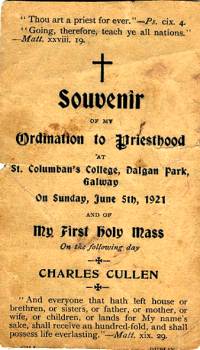
Fr Cullen’s ordination card
Father Charles was one of the first 19 students of the new mission when the first Columban seminary opened on 29 January 1918 at Dalgan Park, Shrule, County Galway. Ordained on 5 June 1921, he left by boat from Cobh for New York on 8 September 1921 and traveled within the USA preaching and fundraising for the cause before setting sail on 26 November 1921 from Seattle - one of the second group of priests to arrive in Hanyang, China, the territory allocated to the Missionary Society of St Columban by the Vatican.
After seven weeks of intensive study of Chinese, Father Charles was sent to his mission station of Ko Cha Dzae. From here he carried out his ministry, sometimes in the outlying districts and sometimes in other stations to cover for absent priests, until his untimely death through illness on 23 July 1923. He was just 27 years old, and the first Columban Missionary to die in the field. Some say that he was also the first Irish Catholic missionary to die in China.
The political turmoil in China resulted in the last missionaries being expelled in 1954. As time went on churches were destroyed or taken over for other purposes; Chinese characters were modernized, and the names of many villages were changed - Ko Cha Dzae disappeared from view. Throughout this time Father Charles lay in his lonely grave, lost, but never forgotten.
Through the efforts of Fr Dan Troy, the Coordinator of the China Mission Unit of the Columbans, and the generosity of the Missionary Society of St Columban, Father Charles' grave was re-located in 2012 and a plaque in his memory was unveiled in the village just prior to the commemoration.
The day concluded with a visit to the cemetery and the commemorative wall plaque where Father Charles' name is recorded.
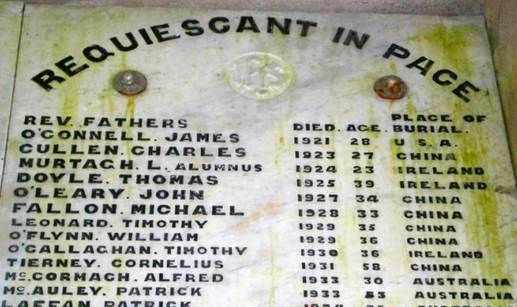
Commemorative wall plaque
You may read a fuller account, written by Carol Noble, of the visit of the Cullen Family to Dalgan Park on the website of the Columbans in Ireland here.
The Cricket in the Box
By Fr Warren Kinne
The author is an Australian Columban who worked in Mindanao in the 1970s. He is now based in Shanghai. He has some Chinese ancestry and during his years in China has come to know relatives there. He wrote this article shortly after the Chinese/Lunar New Year celebration on 8 February 2016.
Chinese Cricket Boxes
There is a Chinese saying: ‘Huo dao lao, xue dao lao’ which loosely translated is ‘You are never too old to learn’.
A couple of nights ago a dentist friend here in China was driving me home on a cold winter’s night when I heard a chirping noise inside the car. It sounded like crickets but I presumed it was an electronic beep somewhere from the dashboard. At the intersection red light, Doctor Dong reached into his pocket and pulled out a small box, opened it, and there were two chirping crickets in two separate wee compartments.
Now the idea of grown men carrying around crickets in boxes, which has a long tradition in China, was something I could never really understand. These male crickets live for a few months and their food is there in a wad of something or other at the end of the box. All they seem to do is make summer noises and fight. You can also buy dried ones for eating.
Crickets for sale in China
Last night on Chinese New Year’s Eve in the beginning of the Year of the Monkey I was home alone and a friend from Australia emailed me and said that there was a good program on SBS (‘Australia’s multicultural and multilingual broadcaster’) that evening about the use of Jade in the Han dynasty. In the day of the VPN (‘virtual private network’) all things are possible and in order to escape the Great Firewall of China (a form of internet censorship), and to circumvent the message that ‘this program is not available in your country’ I put on the VPN for Sydney and started to watch the program.
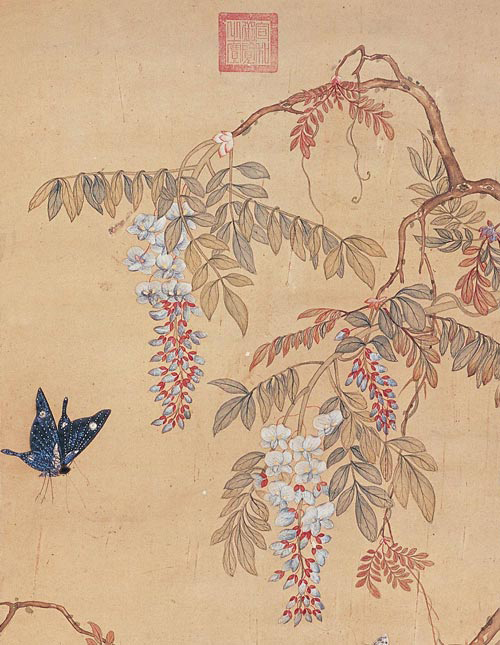
Butterfly and Chinese wisteria, by Xü Xi. Early Song Dynasty, c. 970 [Wikipedia]
There for me was a moment of enlightenment: a key to understanding something of the mythology surrounding the humble cricket for the Chinese. Crickets were not mere pets for chirping or for fighting or for eating. There was also a deeper meaning, at the least for some Chinese. There seems to be something there akin to our metaphor of the butterfly that morphs from chrysalis with grub inside to winged beauty. The cricket lives underground and emerges from the earth resplendent with wings and a voice.
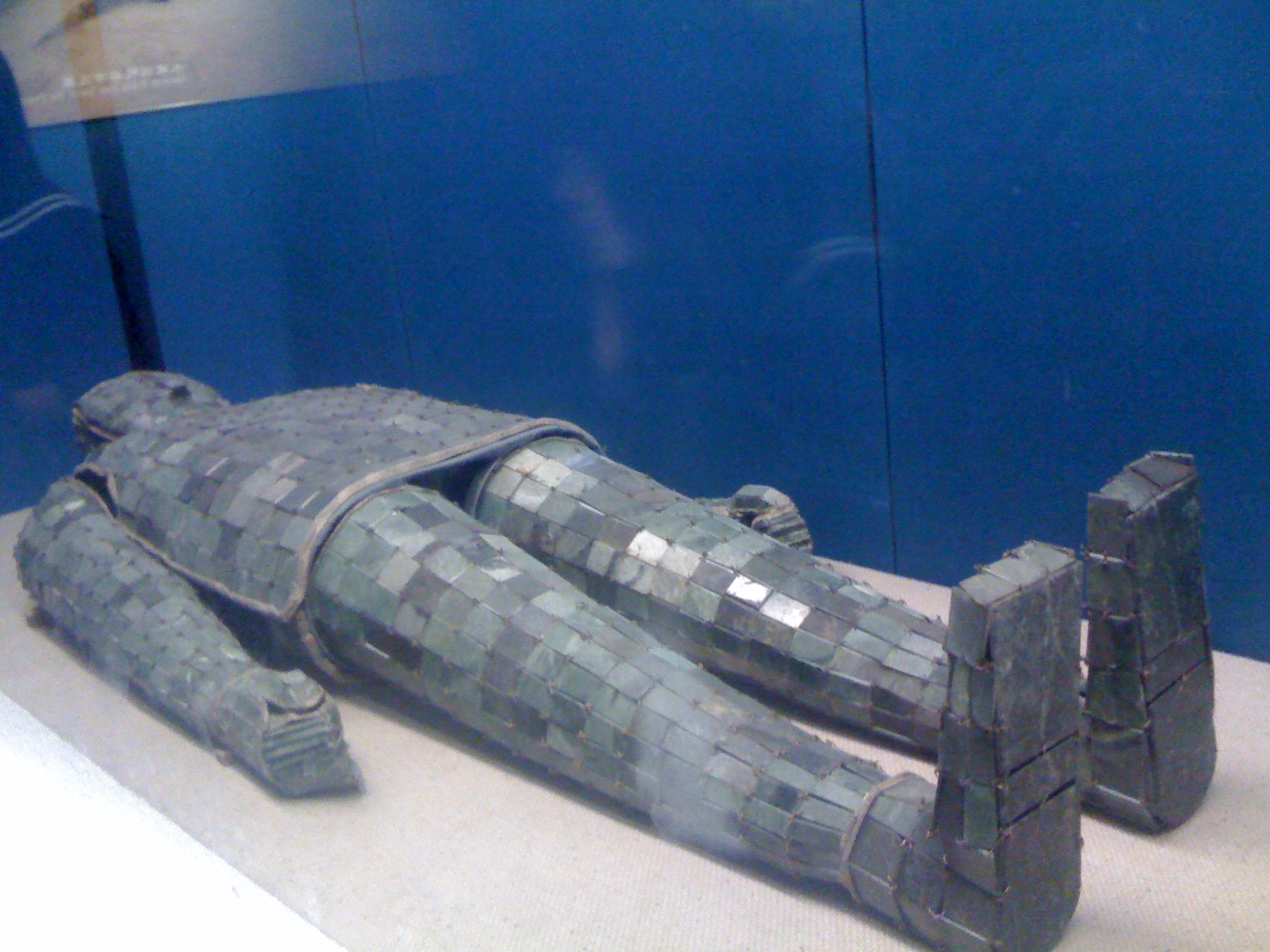
Jade burial suit, tomb of Liu Wu, a Han prince, c.144BC [Wikipedia]
Now what had this to do with jade and the ancient emperors? In unearthing ancient tombs the Chinese have found that their emperors were encased in suits made up of pieces of jade tied together with silver or gold thread. The Emperors were obsessed with immortality. If they had to die because they hadn’t yet found the elixir of eternal youth, at the least there could be life after death. They took with them into their elaborate tombs servants and wives and even soldiers. As time went by a humanism took over and the living were not killed to accompany the emperor into the future life but replicas of people molded in clay. Like the cricket under the earth, they believed that inside the life-giving jade they might rot, but eventually they would resurrect and come forth into the light.
It reminds me of our Easter celebrations of the resurrection of Jesus. In Shanghai this takes place just as the dead wood of winter starts to sprout green shoots. Whether emperor or knave, we all share that desperate search for immortality. For Christians, the elixir is not to be found in being buried in a jade suit but in being imbued with the grace of the risen Lord. From now on I will see that other dimension to the cricket in the box.
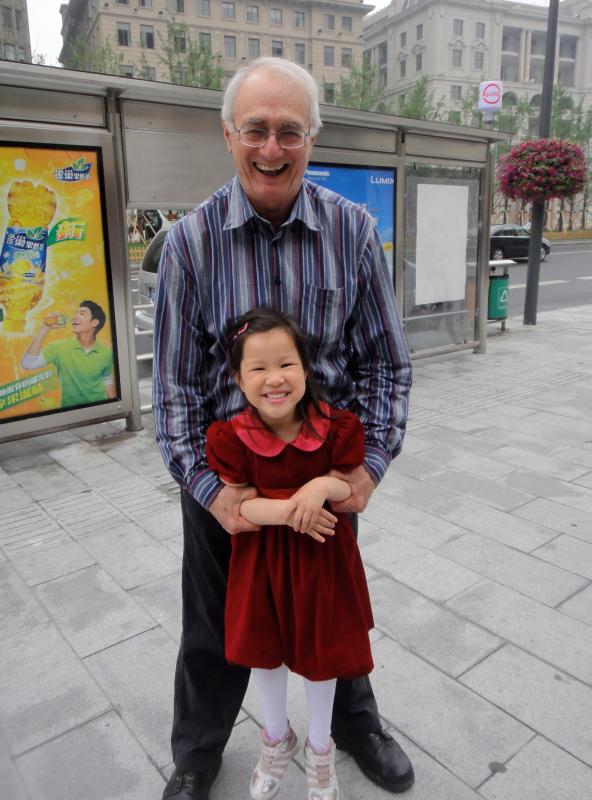
Fr Warren Kinne and Xiao Ai
Read Fr Kinne’s story about his young Chinese friend Xiao Ai: Courage to Live a Lent.
Our Hideaway
 By Ramil Caporas
By Ramil Caporas
The author has been a member of the Philippine Army for 18 years now. He is married with four children. The article is based on an interview made in Hiligaynon through Facebook with Assistant Editor Anne Gubuan.
I was recently tasked to help in the 51st International Eucharistic Congress (IEC) held last 20-31 January in Cebu, Philippines. IEC is basically a gathering of Catholics from around the world but doesn’t limit participation to Catholics only. Though I am a Baptist I didn’t feel hampered in any way in the name of religion. I was privileged to be there and to experience the event. It made me understand more that faith doesn’t depend on labels and classifications; it is all about what our hearts contain.
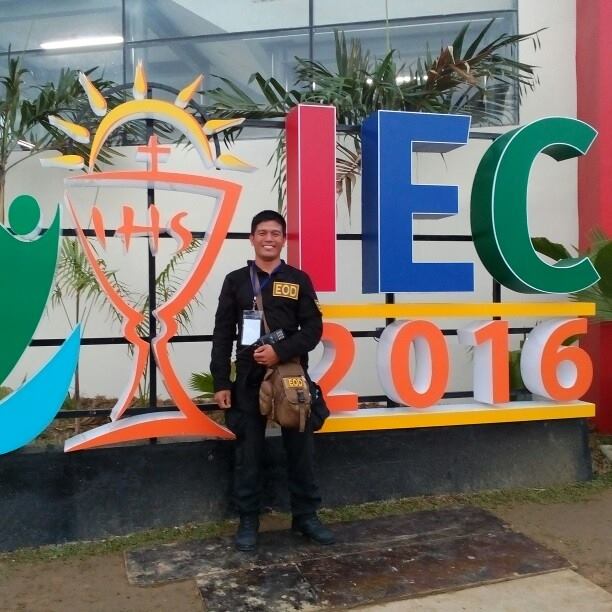
At the IEC, I observed many young people there helping in packing food for the participants, cleaning and preparing the venues. It was quite an experience observing them. They could have been anywhere else having fun, enjoying their time in the malls or on outings. But these young people chose to be there at the IEC, serving the Catholic community, serving the Lord. It made me think of my own 13-year-old daughter. As the father of a teenager, it is my desire that she follow the path of the Lord, to see her involved in meaningful activities that will strengthen her faith and mold her into what God has designed her to be.
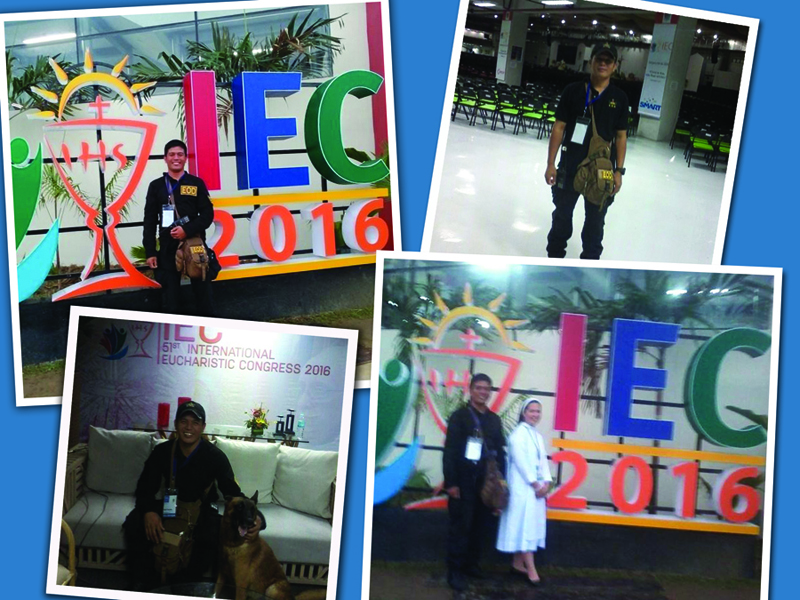
In one of my encounters, a nun gave me a rosary which I accepted wholeheartedly. She got my name and assured me that she would include me in her prayers. That gesture really touched me. I was reminded that we are all sons and daughters of the same one true God. I was even more inspired as I went on with my task. I believe in the faith of the nuns. We implemented very strict security measures at the IEC but I did not encounter any nun angered by our security protocols.
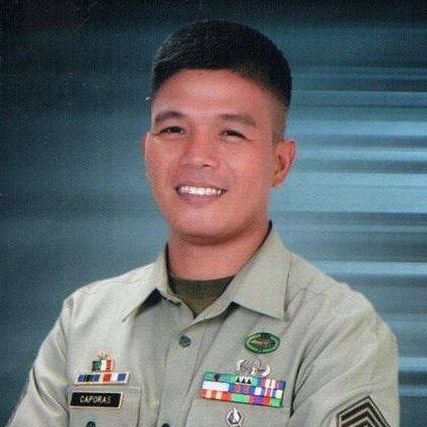
In the military, most of my companions are Catholics. We are always united and when it comes to religion we have mutual respect for one another. We pray together, especially during our activities. As members of the military we are expected to be united. But more than that, we know that we depend on the same God for strength and protection.
Faith, in whatever form, shape or appearance it may have, has been my support in life. Every day I cling to my faith. My life as a military man is risky and fleeting. Anytime, anywhere, there is danger. Death is always imminent. But faith has been my weapon in going about my duties every day.
I believe in having Jesus Christ as the center of our life. Being present at the IEC, I was moved by the faith of the people in the Eucharist, by the way they value it. My religion may be different from that of most of the participants at the IEC, but it didn’t separate me from them. I too was there as a child of God seeking his presence. It was very inspiring. Indeed, the Holy Spirit was present.

Editor’s Postscript
‘We know that we depend on the same God for strength and protection’ So writes Ramil Caporas, a Baptist, in his article above about praying with his comrades, nearly all Catholics. He tells us how touched he was by being given a rosary by a nun and by her assurance that she would pray for him. In the video above an American survivor of a prisoner of war camp in North Korea during the Korean War (1950-1953) tells how ‘Catholic, Protestants and Jews were all praying the rosary every night inspired by their heroic chaplain, Fr Emil Kapaun, who died in that camp on 23 May 1951. St John Paul declared him a Servant of god, the first stage in the process of canonization. Fr Kapaun once applied to join the Columban high school seminary in the USA. ‘As the father of a teenager’
Ramil Caporas writes ‘as the father of a teenager’ that his daughter will be molded ‘into what God has designed her to be’. These words echo those of St Thérèse of Lisieux in her autobiography: ‘Perfection consists simply in doing his will, and being just what he wants us to be.’ |
Peace By Peace
Humanly speaking, we could understand and interpret the Sermon on the Mount in a thousand different ways. Jesus knows only one possibility: simple surrender and obedience, not interpreting it or applying it, but doing and obeying it. That is the only way to hear his word. He does not mean that it is to be discussed as an ideal; he really means us to get on with it.
– Dietrich Bonhoeffer (4 February 1909 – executed 9 April 1945), The Cost of Discipleship


Sophie Scholl, West German stamp 1964 [Wikipedia]
Sophie Scholl, born 9 May 1921, and her brother Hans, born 22 September 1918, were executed by the Nazis on 22 February 1943 for their involvement with White Rose, a movement in the University of Munich that distributed anti-Nazi leaflets.
The only remedy for a barren heart is prayer, however poor and inadequate... if I can't write anything else just now, it’s only because there’s a terrible absurdity about a drowning man who, instead of calling for help, launches into a scientific, philosophical, or theological dissertation while the sinister tentacles of the creatures on the seabed are encircling his arms and legs, and the waves are breaking over him. It’s only because I’m filled with fear, that and nothing else, and feel an undivided yearning for him who can relieve me of it.
– Sophie Scholl, The White Rose written by Sophie’s sister Inge (1917 – 1998).
Sophie Scholl: The Final Days (trailer)
The full movie, with English subtitles, is here.

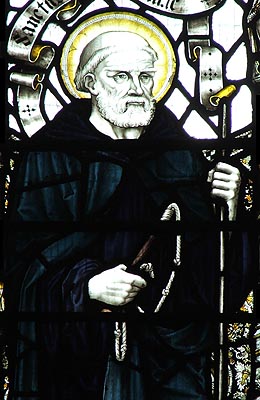
St Guthlac, stained glass, Crowland Abbey, England [Wikipedia]
Have you not read that with him who is united with God in a pure spirit all things are joined together in God, and that he who forsakes the companionship of men, seeks the companionship of animals and the friendship of angels?
– St Guthlac, Hermit (d. 714)

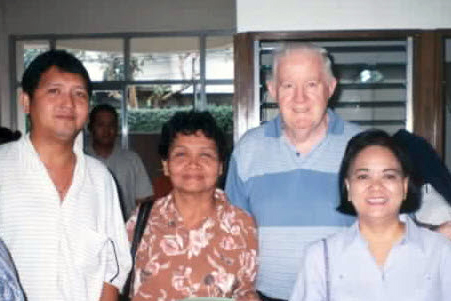
Fr Peter Leonard with friends in Ozamiz City
If our culture can be described as our ‘window on the world,’ then we need to accept that there are endless windows on the world. Other societies have their windows on the world. There are endless ways of perceiving reality and responding to it – all of which have their own validity.
– Columban Fr Peter Leonard (1933 – 2003), Yeast in the Dough
Read Peter Leonard: Man of God (MISYON, November-December 2004)

It is wrong to be sad. Christians cannot be pessimists. Christians must always nourish in their hearts the fullness of joy. Try it, brothers and sisters; I have tried it many times and in the darkest moments, when slander and persecution were at their worst: to unite myself intimately with Christ, my friend, and to feel a comfort that all the joys of the earth do not give – the joy of feeling yourself close to God, even when humans do not understand you. It is the deepest joy the heart can have.
– Blessed Oscar Romero, The Violence of Love.
Blessed Oscar Romero was beatified on 25 May 2015 in San Salvador, Salvador, by Cardinal Amato Angelo SDB

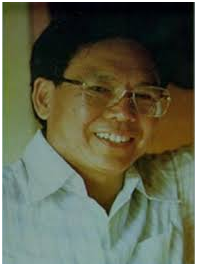
Bishop Bienvenido Tudtud of Marawi [Source]
In a dialogue of life, there is no superiority or inferiority, either in religion or culture. Everyone is on equal footing. There must be a basic respect for the other person. There is no conversion or any attempt under any guise to convert or weaken the faith of the other person – only to convert people to God. We come as ‘learners’ and also as ‘servants’ of the community.
– Bishop Benny Tudtud
(1931 – 1987)

St John Paul II with Young People
‘Rabbi, where are you staying?’ Each day the Church responds: Christ is present in the Eucharist, in the sacrament of His death and resurrection. In and through the Eucharist, you acknowledge the dwelling-place of the Living God in human history. For the Eucharist is the Sacrament of the Love which conquers death. It is the Sacrament of the Covenant, pure Gift of Love for the reconciliation of all humanity. It is the gift of the Real Presence of Jesus The Redeemer, in the bread which is His Body given up for us, in the wine which is His Blood poured out for all. Thanks to the Eucharist, constantly renewed among all peoples of the world, Christ continues to build His church: He brings us together in praise and thanksgiving for salvation, in the communion which only infinite love can forge. Our worldwide gathering now takes on its fullest meaning, through the celebration of the Mass. Dear young friends, may your presence here mean a true commitment in faith! For Christ is now answering your own question and the questions of all those who seek the Living God. He answers by offering an invitation: This is My Body, take It and eat. To the Father He entrusts His supreme desire: that all those whom He loves may be one in the same communion.
– St Pope John Paul II, World Youth Day, Homily on 24 August 1997, Paris, France

To Search is To Find

Father, how true is it that the person who committed suicide cannot be brought to the church for a funeral Mass?
The Catechism of the Catholic Church deals with suicide in numbers 2280 to 2283. The second part of 2282 reads: Grave psychological disturbances, anguish, or grave fear of hardship, suffering, or torture can diminish the responsibility of the one committing suicide. No 2283 states: We should not despair of the eternal salvation of persons who have taken their own lives. By ways known to him alone, God can provide the opportunity for salutary repentance. The Church prays for persons who have taken their own lives.
In the past the Church was very strict in not allowing persons who had committed suicide to have a Catholic funeral. The reasons for this are in Nos 2280 to 2282 of The Catechism: We are stewards, not owners, of the life God has entrusted to us. It is not ours to dispose of . . . Suicide contradicts the natural inclination of the human being to preserve and perpetuate his life. It is gravely contrary to the just love of self . . .
But with the great development in psychology in modern times we have come to understand much more the inner suffering of so many persons that can lead them to a sense of despair. In my experience as a priest for nearly 49 years the Church shows great compassion in cases of suicide. I have been at funerals of persons who took their own lives. My own instinctive reaction when I hear of such a happening is a sense of God’s overwhelming compassion. One Sunday morning 35 years ago when working in a parish in the USA for part of the summer I got a call from a parishioner who had just returned with his wifefrom a weekend away and found their daughter, aged 18 or 19, dead on the floor. She had apparently taken an overdose. One could not but feel a deep sense of sadness, not condemnation.
A couple of years ago while at home in Ireland I was at the funeral Mass of a friend who was a person of deep Catholic faith and who had been very much involved in peace-making in the context of the conflict in Northern Ireland in the latter part of the last century. I was totally unaware of her inner suffering.
When I was a young priest studying in the USA a religious sister, a counsellor, advised me to take any talk of suicide seriously. I found her advice to be life-saving in a number of subsequent situations. There have been at least three occasions when I am certain that, through God’s grace, I was instrumental in preventing suicide. On one of those occasions I was ‘chatting’ online with a friend on the other side of the world.
I have also learned that some persons with deep, committed Christian faith, can be very fragile.
One who has written quite a bit about suicide is internationally-syndicated Canadian columnist Fr Ronald Rolheiser OMI. If you google ‘Ronald Rolheiser, suicide’ you can find many of his columns on this topic.
This question and answer do not deal with those who deliberately take their lives and those of others such as suicide bombers. Nor does it deal with the question of euthanasia / 'assisted suicide', which has been legalised in some countries and is, as The Catechism states, 'morally unacceptable' (Nos 2276-2279). They deal with those who take their lives because of inner pressures that they find unbearable.
A final word, when a priest is giving the homily at the funeral Mass of someone who has committed suicide, he must proclaim the reality of the Resurrection in a way that gives hope to those present without in any way justifying the act of taking one’s life, which is always objectively, gravely wrong. But only God can fully understand the deep suffering of the person who has died as well as the suffering of those left behind.

